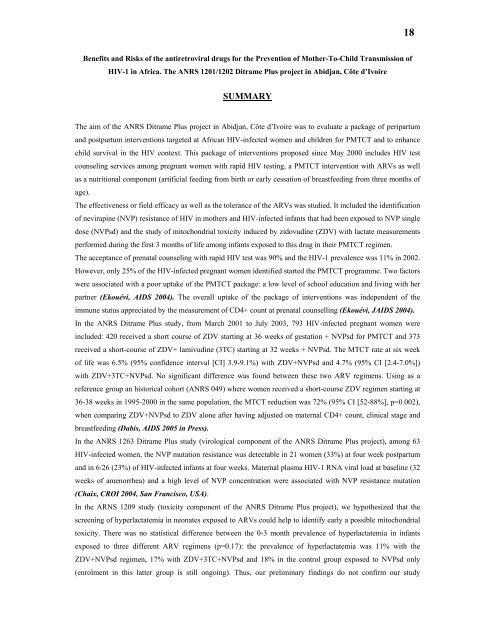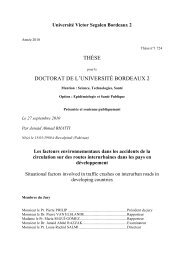Télécharger le texte intégral - ISPED-Enseignement à distance
Télécharger le texte intégral - ISPED-Enseignement à distance
Télécharger le texte intégral - ISPED-Enseignement à distance
You also want an ePaper? Increase the reach of your titles
YUMPU automatically turns print PDFs into web optimized ePapers that Google loves.
18<br />
Benefits and Risks of the antiretroviral drugs for the Prevention of Mother-To-Child Transmission of<br />
HIV-1 in Africa. The ANRS 1201/1202 Ditrame Plus project in Abidjan, Côte d’Ivoire<br />
SUMMARY<br />
The aim of the ANRS Ditrame Plus project in Abidjan, Côte d’Ivoire was to evaluate a package of peripartum<br />
and postpartum interventions targeted at African HIV-infected women and children for PMTCT and to enhance<br />
child survival in the HIV context. This package of interventions proposed since May 2000 includes HIV test<br />
counseling services among pregnant women with rapid HIV testing, a PMTCT intervention with ARVs as well<br />
as a nutritional component (artificial feeding from birth or early cessation of breastfeeding from three months of<br />
age).<br />
The effectiveness or field efficacy as well as the to<strong>le</strong>rance of the ARVs was studied. It included the identification<br />
of nevirapine (NVP) resistance of HIV in mothers and HIV-infected infants that had been exposed to NVP sing<strong>le</strong><br />
dose (NVPsd) and the study of mitochondrial toxicity induced by zidovudine (ZDV) with lactate measurements<br />
performed during the first 3 months of life among infants exposed to this drug in their PMTCT regimen.<br />
The acceptance of prenatal counseling with rapid HIV test was 90% and the HIV-1 preva<strong>le</strong>nce was 11% in 2002.<br />
However, only 25% of the HIV-infected pregnant women identified started the PMTCT programme. Two factors<br />
were associated with a poor uptake of the PMTCT package: a low <strong>le</strong>vel of school education and living with her<br />
partner (Ekouévi, AIDS 2004). The overall uptake of the package of interventions was independent of the<br />
immune status appreciated by the measurement of CD4+ count at prenatal counselling (Ekouévi, JAIDS 2004).<br />
In the ANRS Ditrame Plus study, from March 2001 to July 2003, 793 HIV-infected pregnant women were<br />
included: 420 received a short course of ZDV starting at 36 weeks of gestation + NVPsd for PMTCT and 373<br />
received a short-course of ZDV+ lamivudine (3TC) starting at 32 weeks + NVPsd. The MTCT rate at six week<br />
of life was 6.5% (95% confidence interval [CI] 3.9-9.1%) with ZDV+NVPsd and 4.7% (95% CI [2.4-7.0%])<br />
with ZDV+3TC+NVPsd. No significant difference was found between these two ARV regimens. Using as a<br />
reference group an historical cohort (ANRS 049) where women received a short-course ZDV regimen starting at<br />
36-38 weeks in 1995-2000 in the same population, the MTCT reduction was 72% (95% CI [52-88%], p=0.002),<br />
when comparing ZDV+NVPsd to ZDV alone after having adjusted on maternal CD4+ count, clinical stage and<br />
breastfeeding (Dabis, AIDS 2005 in Press).<br />
In the ANRS 1263 Ditrame Plus study (virological component of the ANRS Ditrame Plus project), among 63<br />
HIV-infected women, the NVP mutation resistance was detectab<strong>le</strong> in 21 women (33%) at four week postpartum<br />
and in 6/26 (23%) of HIV-infected infants at four weeks. Maternal plasma HIV-1 RNA viral load at baseline (32<br />
weeks of amenorrhea) and a high <strong>le</strong>vel of NVP concentration were associated with NVP resistance mutation<br />
(Chaix, CROI 2004, San Francisco, USA).<br />
In the ARNS 1209 study (toxicity component of the ANRS Ditrame Plus project), we hypothesized that the<br />
screening of hyperlactatemia in neonates exposed to ARVs could help to identify early a possib<strong>le</strong> mitochondrial<br />
toxicity. There was no statistical difference between the 0-3 month preva<strong>le</strong>nce of hyperlactatemia in infants<br />
exposed to three different ARV regimens (p=0.17): the preva<strong>le</strong>nce of hyperlactatemia was 11% with the<br />
ZDV+NVPsd regimen, 17% with ZDV+3TC+NVPsd and 18% in the control group exposed to NVPsd only<br />
(enrolment in this latter group is still ongoing). Thus, our preliminary findings do not confirm our study
















